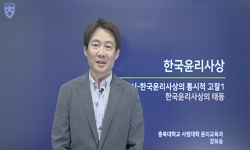七情은 본래부터 도덕감정을 통칭하는 용어인 데 반해, 맹자의 四端, 즉 `네 가지 실마리`라는 개념은 도덕본성을 추론하기 위한 방편으로 제기된 것이다. 따라서 도덕본성과의 관계를 고려...
http://chineseinput.net/에서 pinyin(병음)방식으로 중국어를 변환할 수 있습니다.
변환된 중국어를 복사하여 사용하시면 됩니다.
- 中文 을 입력하시려면 zhongwen을 입력하시고 space를누르시면됩니다.
- 北京 을 입력하시려면 beijing을 입력하시고 space를 누르시면 됩니다.

도덕감정과 도덕본성의 관계: 퇴계의 문제의식에 대한 검토 = The Relationship between Moral Emotions and Moral Nature: A Review of Toegye`s Philosophical Quest for Moral Spontaneity
한글로보기https://www.riss.kr/link?id=A103036355
- 저자
- 발행기관
- 학술지명
- 권호사항
-
발행연도
2017
-
작성언어
Korean
-
주제어
한국유학 ; 한국성리학 ; 퇴계 이황 ; 사단 ; 칠정 ; 도덕감정 ; 도덕본성 ; Korean Confucianism ; Korean Neo-Confucianism ; Toegye Yi Hwang ; Four Beginnings ; Seven Emotions ; moral emotions ; moral nature.
-
등재정보
KCI등재
-
자료형태
학술저널
-
수록면
327-356(30쪽)
-
KCI 피인용횟수
7
- DOI식별코드
- 제공처
-
0
상세조회 -
0
다운로드
부가정보
국문 초록 (Abstract)
七情은 본래부터 도덕감정을 통칭하는 용어인 데 반해, 맹자의 四端, 즉 `네 가지 실마리`라는 개념은 도덕본성을 추론하기 위한 방편으로 제기된 것이다. 따라서 도덕본성과의 관계를 고려하지 않고 四端을 논하는 것은 의미가 없다. 주자는 도덕본성과 도덕감정을 理氣論의 틀로 설명함으로써 인식 가능한 영역[감정]과 인식 불가능한 영역[본성] 사이에 놓인 深淵의 間隙을 넘어 두 영역의 구조와 작용을 일관된 방식으로 설명할 수 있었다. 그리고 이를 통해 도덕규범의 당위성은 자연법칙과 같은 수준의 필연성을 확보하게 된다. 그러나 작용하는 것은 氣이고 그 작용의 기준은 理라는 설명 방식으로는 맹자가 말하려 했던 인간 내면의 도덕적 자발성, 그 도덕성의 욕구를 설명할 수 없다. 퇴계는 바로 그러한 마음의 도덕적 자발성이 성리학적 이상사회의 실현을 위한 출발점이 된다고 생각하였다. 퇴계는 사단칠정논쟁 과정을 통해 선한 도덕본성의 자발성을 표현하는 방법에 대해 고민하며 理發說을 제기하였고, 논쟁 이후 고봉과 物格에 대한 논의를 계속하면서 理自到說을 제기하게 된다. 퇴계는 원리·규범을 의미하는 형이상학적 개념으로서의 理와 `발현(發)`, `(스스로) 이르다((自)到)`와 같은 현상 기술의 술어를 결합시킴으로써 도덕이상사회 실현의 출발점이 되는 인간 자신의 도덕적 자발성, 그 도덕적 욕구의 형이상학적 충동을 은유적으로 설명해 내었다.
다국어 초록 (Multilingual Abstract)
Moral emotions can be identified through humans` cognitive ability; however, there exists a state of heart-mind (心) where emotions are not yet revealed-this can be called moral nature or unexpressed heart-mind and cannot be identified easily. While ...
Moral emotions can be identified through humans` cognitive ability; however, there exists a state of heart-mind (心) where emotions are not yet revealed-this can be called moral nature or unexpressed heart-mind and cannot be identified easily. While the term “Seven Emotions” (七情) is commonly used in Confucianism to refer to all moral feelings, Mengzi`s “Four Beginnings” or “Four Clues” (四端) was originally suggested as a temporary way to infer humanity`s moral nature. It is therefore meaningless to discuss the Four Beginnings without considering their relationship to humanity`s moral nature. Using li-gi (理氣) theory to explain humans` moral nature and emotions, Zhu Xi was able to consistently illustrate both areas` structures and functions and bridge the deep gap between the cognizable realm of moral emotions and the noncognizable realm of moral nature. As a result of Zhu Xi`s work, the appropriateness of moral norms could secure the same degree of inevitability as the laws of nature. However, Zhu Xi`s theory could not elucidate human moral spontaneity or ethical desire that Mengzi tried to illustrate with his Four Beginnings. This is because what Mengzi wrote about was not emotions as physical actions that could be explained by the function of gi (氣), but instead the spontaneous human desire of moral nature that originates from li (理). Toegye Yi Hwang (退溪 李滉) believed the moral spontaneity of heart-mind was the starting point to realizing an ideal Neo-Confuciansociety. Grappling with how to express the spontaneity of moral nature through the Four-Seven Debates with Gobong Gi Daeseung (高峯 奇大升), Toegye proposed the proposition “li issues” (理發). After the debates, while discussing the interpretation of mulgyeok (物格), he suggested another proposition: “li comes by itself” (理自到). By combining li as a metaphysical concept - meaning principle and norms - with predicate verbs such as “issue” and “come by itself,” which are used to delineate the phenomenal world, Toegye was able to utilize self-motivation or man`s own ethical desire as a starting point to realize the morally ideal Neo-Confucian society. After Toegye, Joseon Dynasty scholars, including Gobong and Yulgok Yi I (栗谷 李珥), studied and discussed the functions of the natural principle and humanity`s moral nature, regardless of whether they agreed with Toegye. His ideas eventually had a tremendous effect on the development of Joseon Confucianism.
참고문헌 (Reference)
1 金炯瓚, "理氣論의 一元論化 硏究" 高麗大學校 大學院 1996
2 윤사순, "한국유학사상론" 예문서원 1997
3 문석윤, "퇴계에서 理發과 理動, 理到의 의미에 대하여" 퇴계학연구원 110 : 2001
4 남지만, "고봉 기대승의 성리설 연구" 고려대학교 대학원 2009
5 奇大升, "高峯集" 민족문화추진회 1988
6 奇大升, "高峯全集" 성균관대학교 대동문화연구원 1979
7 李滉, "退溪集" 민족문화추진회 1988
8 "禮記"
9 朱熹, "朱子全書" 上海古籍出版社 2002
10 "性理大全" 보경문화사 1994
1 金炯瓚, "理氣論의 一元論化 硏究" 高麗大學校 大學院 1996
2 윤사순, "한국유학사상론" 예문서원 1997
3 문석윤, "퇴계에서 理發과 理動, 理到의 의미에 대하여" 퇴계학연구원 110 : 2001
4 남지만, "고봉 기대승의 성리설 연구" 고려대학교 대학원 2009
5 奇大升, "高峯集" 민족문화추진회 1988
6 奇大升, "高峯全集" 성균관대학교 대동문화연구원 1979
7 李滉, "退溪集" 민족문화추진회 1988
8 "禮記"
9 朱熹, "朱子全書" 上海古籍出版社 2002
10 "性理大全" 보경문화사 1994
11 "孟子"
12 "四書大全 (상, 하)" 술이 2012
13 Tu Wei-ming, "The Rise of Neo-Confucianiam in Korea" Columbia University Press 1985
14 김형찬, "THE LI-KI STRUCTURE OF THE FOUR BEGINNINGS AND THE SEVEN EMOTIONS AND THE INTENT OF THE FOUR-SEVEN DEBATE: A CRITICAL REFLECTION ON THE METHODS OF EXPLAINING THE THEORIES OF THE FOUR BEGINNINGS AND THE SEVEN EMOTIONS IN KOREAN NEO-CONFUCIANISM" 한국학연구원 18 (18): 561-581, 2015
15 Owen Flanagan, "Moral Sprouts and Natural Teleologies" Marquette University Press 2014
16 Mark Johnson, "Moral Imagination: Implication of Cognitive Science" The University of Chicago Press 1993
17 김형찬, "Internalizing Morals and the Active Intervention of a Moral System: Zhu Xi and Yi Hwang’s Theories of kyŏngmul 格物 and mulgyŏk 物格" 종교연구소 6 (6): 5-26, 2015
동일학술지(권/호) 다른 논문
-
『악학궤범(樂學軌範)』 악율론(樂律論)의 역학적(易學的) 분석(分析) - 황종(黃鍾)을 중심으로 -
- 고려대학교 민족문화연구원
- 조희영 ( Cho Hie-young )
- 2017
- KCI등재
-
- 고려대학교 민족문화연구원
- 한용진 ( Hahn Yong-jin )
- 2017
- KCI등재
-
- 고려대학교 민족문화연구원
- 김영운
- 2017
- KCI등재
-
한벽당(寒碧堂) 곽기수(郭期壽)의 국문시가 향유 양상과 시가사적 의미
- 고려대학교 민족문화연구원
- 조지형 ( Cho Ji-hyoung )
- 2017
- KCI등재
분석정보
인용정보 인용지수 설명보기
학술지 이력
| 연월일 | 이력구분 | 이력상세 | 등재구분 |
|---|---|---|---|
| 2026 | 평가예정 | 재인증평가 신청대상 (재인증) | |
| 2020-01-01 | 평가 | 등재학술지 유지 (재인증) |  |
| 2017-01-01 | 평가 | 등재학술지 유지 (계속평가) |  |
| 2015-03-17 | 학술지명변경 | 외국어명 : 미등록 -> Korean Cultural Studies |  |
| 2013-01-01 | 평가 | 등재 1차 FAIL (등재유지) |  |
| 2010-01-01 | 평가 | 등재학술지 유지 (등재유지) |  |
| 2009-06-18 | 학회명변경 | 영문명 : Institute of Korean Culture -> Research Institute of Korean Studies |  |
| 2008-01-01 | 평가 | 등재학술지 유지 (등재유지) |  |
| 2005-10-18 | 학술지명변경 | 한글명 : 민족문화연구 29호 -> 민족문화연구 |  |
| 2005-01-01 | 평가 | 등재학술지 선정 (등재후보2차) |  |
| 2004-01-01 | 평가 | 등재후보 1차 PASS (등재후보1차) |  |
| 2002-01-01 | 평가 | 등재후보학술지 선정 (신규평가) |  |
학술지 인용정보
| 기준연도 | WOS-KCI 통합IF(2년) | KCIF(2년) | KCIF(3년) |
|---|---|---|---|
| 2016 | 0.77 | 0.77 | 0.7 |
| KCIF(4년) | KCIF(5년) | 중심성지수(3년) | 즉시성지수 |
| 0.71 | 0.7 | 1.385 | 0.15 |





 KCI
KCI KISS
KISS



